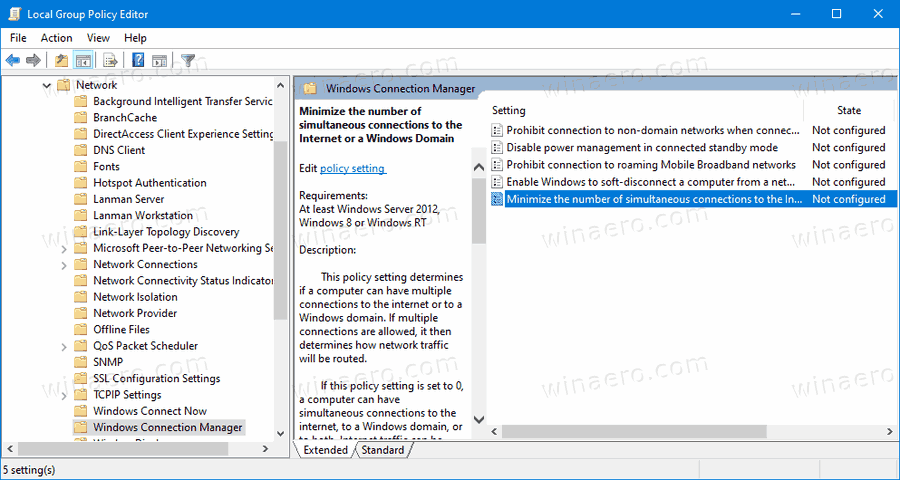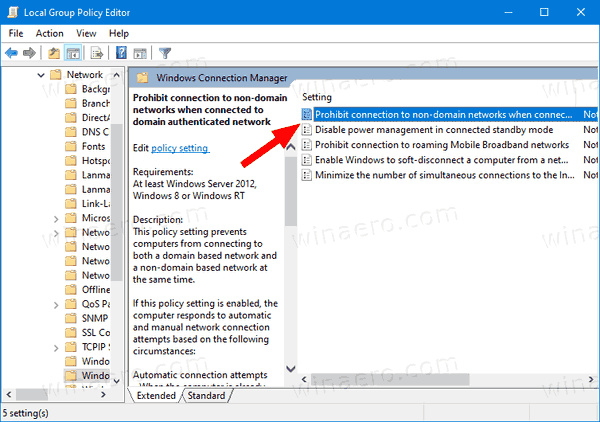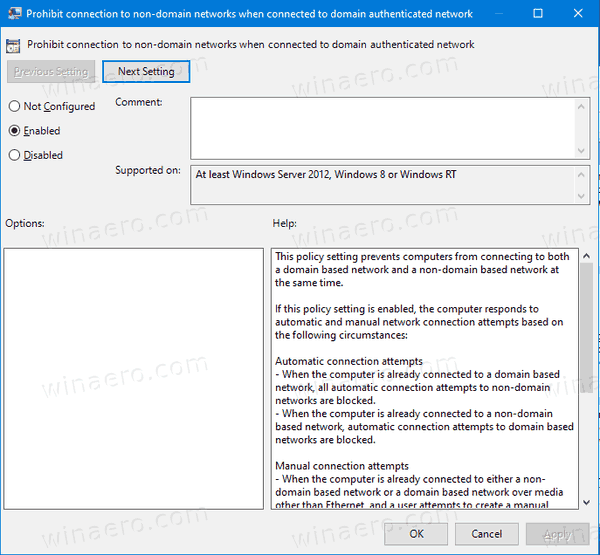How to Disable Simultaneous Connection to Non-domain and Domain in Windows 10
You can use the Prohibit connection to non-domain networks when connected to domain authenticated network policy in Windows 10 to disable (or enable) simultaneous connection to Non-domain and Domain networks. Here are two methods you can use to configure the policy.
Advertisеment
When the Prohibit connection to non-domain networks when connected to domain authenticated network policy option is Enabled, responds to automatic and manual network connection attempts based on the following circumstances:
Automatic connection attempts
- When the computer is already connected to a domain based network, all automatic connection attempts to non-domain networks are blocked.
- When the computer is already connected to a non-domain based network, automatic connection attempts to domain based networks are blocked.
Manual connection attempts
- When the computer is already connected to either a non-domain based network or a domain based network over media other than Ethernet, and a user attempts to create a manual connection to an additional network in violation of this policy setting, the existing network connection is disconnected and the manual connection is allowed.
- When the computer is already connected to either a non-domain based network or a domain based network over Ethernet, and a user attempts to create a manual connection to an additional network in violation of this policy setting, the existing Ethernet connection is maintained and the manual connection attempt is blocked.
If this policy setting is not configured or is disabled, computers are allowed to connect simultaneously to both domain and non-domain networks.
If you are running Windows 10 Pro, Enterprise, or Education edition, then you can use the Local Group Policy Editor app to configure the policy option. It is available in the OS out of the box. Windows 10 Home users can apply a Registry tweak. Let's review these methods.
An administrative account is required to continue.
To Disable Simultaneous Connection to Non-domain and Domain in Windows 10,
- Open the Local Group Policy editor app, or launch it for all users except Administrator, or for a specif user.
- Navigate to Computer Configuration\Administrative Templates\Network\Windows Connection Manager on the left.

- On the right, find the policy setting Prohibit connection to non-domain networks when connected to domain authenticated network.

- Double-click on it and set the policy to Enabled.

You are done.
Alternatively, you can apply a Registry tweak.
Disable Simultaneous Connection to Non-domain and Domain in Registry
- Open Registry Editor.
- Go to the following Registry key:
HKEY_LOCAL_MACHINE\Software\Policies\Microsoft\Windows\WcmSvc\GroupPolicy.Tip: See how to jump to the desired Registry key with one click. - If you do not have such a key, then just create it.
- Here, create a new 32-bit DWORD value fBlockNonDomain. Note: Even if you are running 64-bit Windows, you still need to use a 32-bit DWORD as the value type.
- Set it to
1to To disable simultaneous connections to both Non-domain and Domain networks. - To make the changes done by the Registry tweak take effect, you need to restart Windows 10.
Later, you can delete the fBlockNonDomain value to restore the system defaults.
You can also download the following ready-to-use Registry files, including the undo tweak:
That's it.
Tip: You can try to enable GpEdit.msc in Windows 10 Home.
Articles of interest:
- How To See Applied Group Policies in Windows 10
- All Ways To Open Local Group Policy Editor in Windows 10
- Apply Group Policy to All Users Except Administrator in Windows 10
- Apply Group Policy to a Specific User in Windows 10
- Reset All Local Group Policy Settings at once in Windows 10
- Enable Gpedit.msc (Group Policy) in Windows 10 Home
Support us
Winaero greatly relies on your support. You can help the site keep bringing you interesting and useful content and software by using these options:
